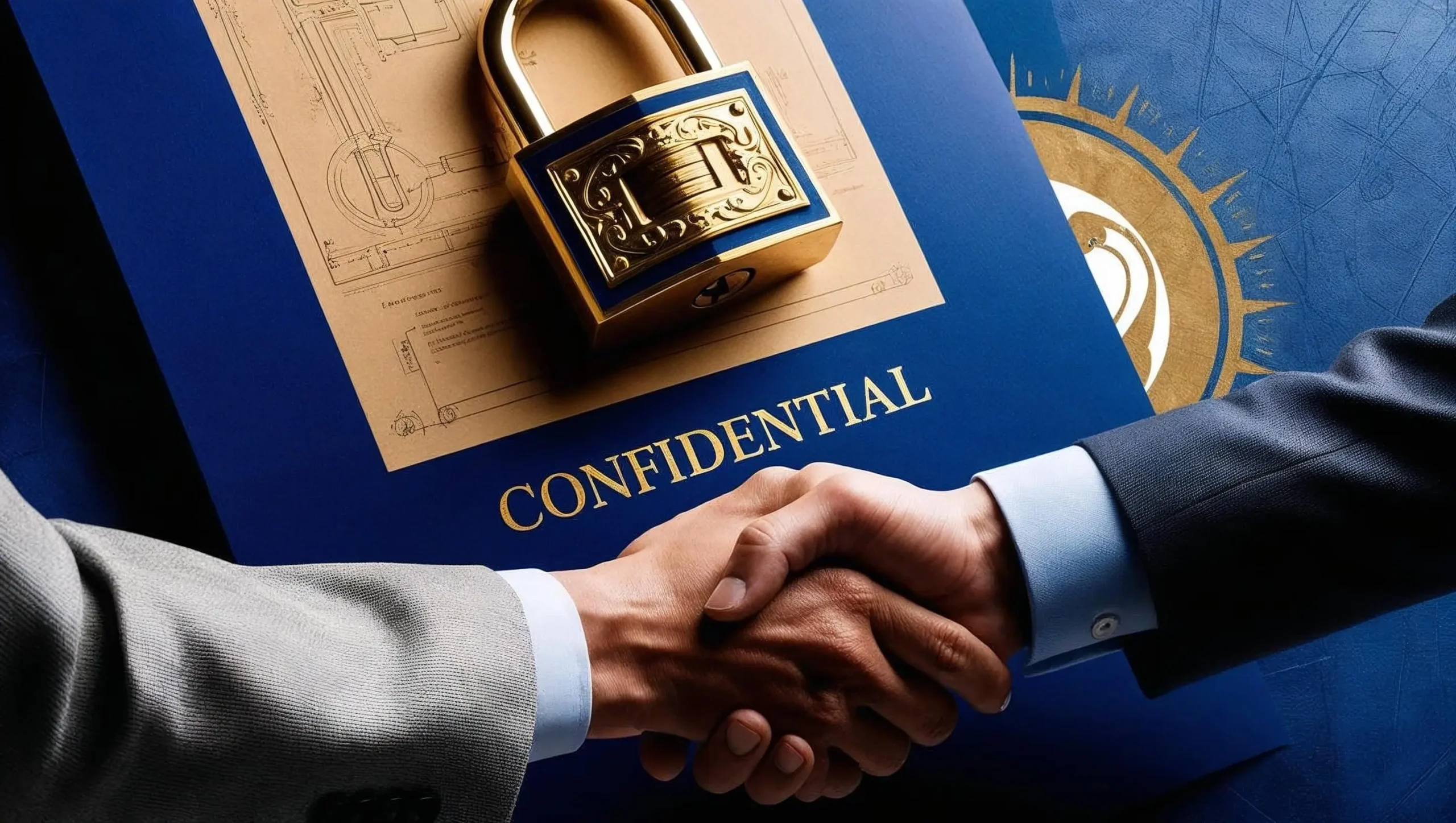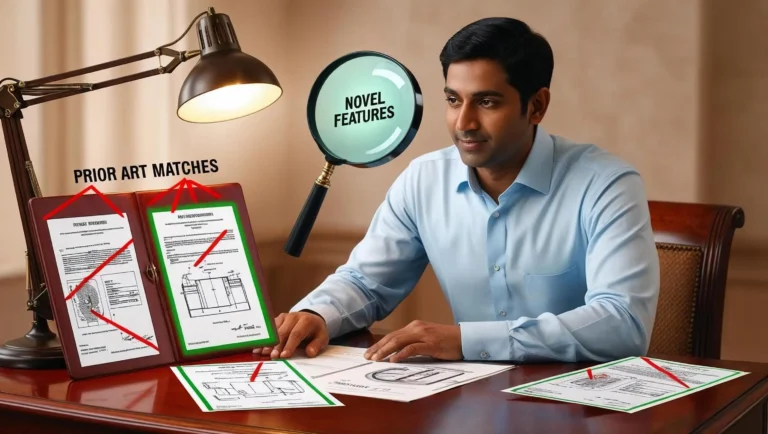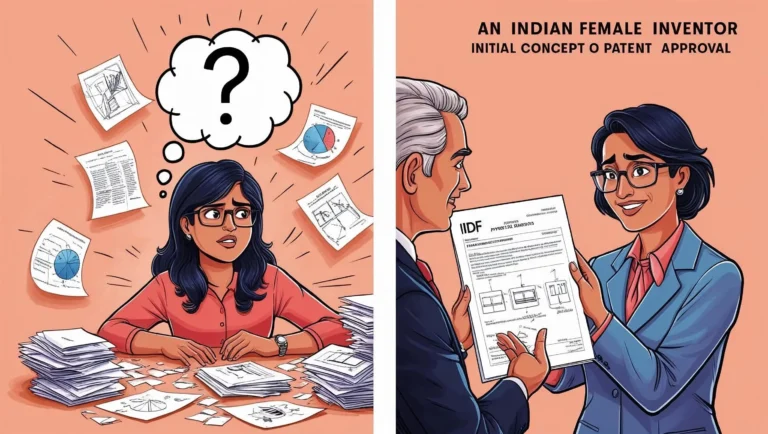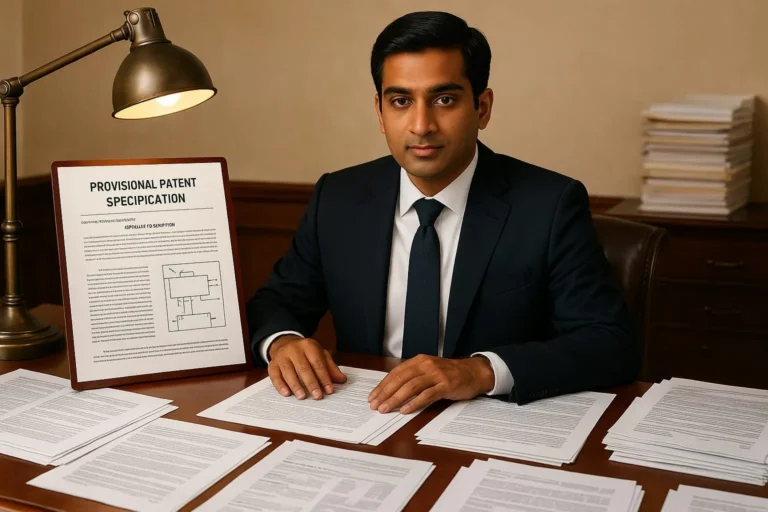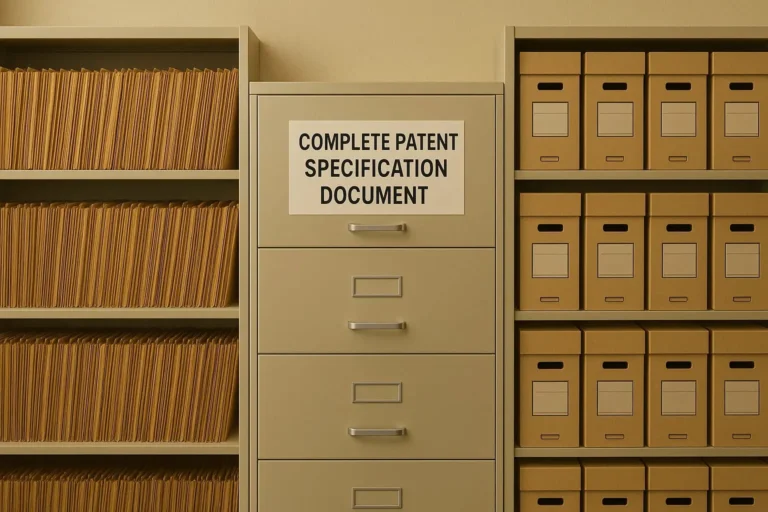Non-Disclosure Agreements: Protecting Your Invention’s Confidentiality
Why should you read this article on Non-Disclosure Agreements (NDAs) from start to end?
The primary objective of this article is to guide inventors and businesses through the critical importance of Non-Disclosure Agreements in the intellectual property protection process, using simple, easy-to-understand language. We’ll explore what an NDA is, why it’s absolutely essential before sharing any details of your invention with patent attorney, patent agents or any third party, and the key components that make an effective NDA.
The second objective is to provide a clear understanding of the critical clauses and provisions that should be included in your NDA to ensure maximum protection. We’ll examine each important element step by step and discuss what inventors should look for when reviewing an NDA to ensure their confidential information remains secure while avoiding potentially dangerous omissions.
Table of Contents
1.What is a Non-Disclosure Agreement (NDA)?
2.Why is an NDA Absolutely Essential for Inventors?
3.Types of NDAs You Should Know About
4.Essential Components of an Effective NDA
- Clear Identification of Parties
- Comprehensive Definition of Confidential Information
- Clearly Defined Obligations of the Receiving Party
- Exclusions from Confidentiality
- Term and Duration of Confidentiality
- Return or Destruction of Confidential Information
- Remedies for Breach
- Governing Law and Jurisdiction
5.Red Flags to Watch for in NDAs
6.Practical Tips for Using NDAs Effectively
7.The Cost Factor of NDAs
8.Key Components of an NDA at a Glance
9.Conclusion
10.FAQs About Non-Disclosure Agreements
What is a Non-Disclosure Agreement (NDA)?
A Non-Disclosure Agreement, commonly referred to as an NDA, is a legally binding contract between two or more parties that establishes a confidential relationship. The primary purpose of the NDA is to protect sensitive information from being shared with third parties. In the context of patent filing and intellectual property protection, the NDA serves as the first line of defense for your invention before you secure legal protection through patents.
The NDA creates clear legal obligations for anyone who receives information about your invention to keep that information confidential. This contractual protection is crucial during the early stages of invention development, especially before filing a patent application when your idea is most vulnerable to theft or unauthorized disclosure.
Why is an NDA Absolutely Essential for Inventors?
As emphasized in our guide patent filing cost in India, the NDA stage is the first and most critical step in the patent process.
Before your patent application is filed, your invention lacks formal legal protection. During this vulnerable period, anyone who learns about your invention could potentially claim it as their own or publicly disclose it, which could destroy your ability to obtain a patent. Remember, in many jurisdictions including India, public disclosure of an invention before filing a patent application can invalidate your right to patent protection.
The NDA provides a crucial legal shield during this pre-patent period. It legally binds the receiving party to maintain confidentiality, giving you legal recourse if they breach this trust. Without an NDA, you would have limited legal grounds to fight against unauthorized use or disclosure of your invention.
Even when discussing your invention with professionals like patent attorneys or potential business partners, an NDA should be your prerequisite for any conversation. This applies to friends, family members, potential investors, manufacturers, or anyone else with whom you might need to share details about your invention.
Types of NDAs You Should Know About
Depending on your specific situation, you might need different types of NDAs:
Unilateral NDA: This is the most common type for inventors. In a unilateral NDA, you (the inventor) are sharing confidential information, and the other party agrees to keep it confidential. This is typically used when consulting with patent attorneys, approaching manufacturers, or presenting to potential investors.
Bilateral (Mutual) NDA: In this type, both parties exchange confidential information and agree to protect each other’s data. This might be appropriate when collaborating with another inventor or when forming a joint venture where both parties contribute proprietary information.
Multilateral NDA: This involves three or more parties where confidential information is shared, and all parties agree to maintain confidentiality. This could be necessary for complex collaborations involving multiple stakeholders.
For most individual inventors, a unilateral NDA is sufficient when sharing invention details with a patent attorney or agent. The sample NDA document attached to this article is an example of a unilateral NDA where the inventor is the “Disclosing Party” and the patent professional is the “Receiving Party.”
Essential Components of an Effective NDA
When reviewing or preparing an NDA for your invention, ensure it contains these critical elements:
1. Clear Identification of Parties
The NDA should clearly identify who is disclosing the confidential information (typically you, the inventor) and who is receiving it (the patent attorney, potential partner, etc.). This includes full legal names and addresses of all parties involved.
For example, in the NDA document, this is specified at the beginning:
This Non-Disclosure Agreement (“Agreement”) is made and entered into on this ___ day of _____________ 2024, (“Effective Date”) between:
[Name of company], having its principal place of business [Address], hereinafter referred to as the “Disclosing Party”;
AND
Legismith Partners LLP having its principal place of business at Office No. 507, Sukhwani Boulevard Commerz, Pashan – Sus Road, above Domino’s, Sus, Pune-411021, hereinafter referred to as the “Receiving Party”.
2. Comprehensive Definition of Confidential Information
Your NDA should clearly define what constitutes “Confidential Information.” This definition should be broad enough to cover all aspects of your invention, including technical specifications, drawings, processes, materials, potential applications, and any other pertinent details.
A proper definition, in NDA, might read:
“Confidential Information” shall include any and all information, whether written, oral, or in any other form, disclosed by the Disclosing Party to the Receiving Party that is marked or identified as confidential or proprietary at the time of disclosure or should reasonably be considered as confidential or proprietary given the nature of the information and the circumstances of disclosure.
Pay close attention to the wording here. The definition covers information in any form—written, oral, or otherwise—ensuring comprehensive protection. It also includes information that should “reasonably be considered” confidential, providing additional protection for information that might not be explicitly marked as confidential.
3. Clearly Defined Obligations of the Receiving Party
This section outlines what the receiving party can and cannot do with your confidential information. It should specify:
- The duty to maintain strict confidentiality
- Restrictions on use (typically limited to the specific purpose agreed upon)
- Prohibition against disclosure to third parties without authorization
- Required security measures to prevent unauthorized access
In the sample NDA, this is covered under the “Non-Disclosure Obligations” section:
The Receiving Party agrees to maintain the Confidential Information in strict confidence and undertakes not to use, disclose, or make the Confidential Information available to any third party without the prior written consent of the Disclosing Party. The Receiving Party shall take all reasonable precautions to protect Confidential Information from unauthorized access, use, or disclosure.
The Receiving Party may use the Confidential Information solely for the purpose of providing patent agent services to the Disclosing Party and for no other purpose without the explicit written consent of the Disclosing Party.
4. Exclusions from Confidentiality
While you want your NDA to be comprehensive, it should also be reasonable. Standard NDAs typically exclude certain categories of information from confidentiality obligations, such as:
- Information that is already publicly known (not through a breach of the NDA)
- Information the receiving party already knew before disclosure
- Information independently developed by the receiving party without using your confidential information
- Information received from a third party who wasn’t under confidentiality obligations
- Information required to be disclosed by law or court order
These exclusions are standard in most NDAs and make the agreement more legally enforceable by acknowledging reasonable limitations.
5. Term and Duration of Confidentiality
Your NDA should clearly specify:
- When the agreement takes effect (usually the date of signing)
- How long the confidentiality obligations last
- What happens when the agreement terminates
For inventions, longer confidentiality periods are generally better. Some NDAs specify confidentiality obligations that survive the termination of the agreement itself. In the sample NDA, the term is specified as:
This Agreement shall commence on the Effective Date and shall continue in effect for 3 months or until terminated by either party upon written notice.
While three months might be sufficient for initial consultations with a patent professional, you might want to consider a longer term (often 3-5 years or even indefinite) for agreements with other parties, especially those not directly involved in your patent filing process.
6. Return or Destruction of Confidential Information
This clause requires the receiving party to return or destroy all confidential information when the agreement ends or upon your request. This helps ensure your information doesn’t remain in circulation after your relationship with the receiving party concludes.
As stated in the sample NDA:
Upon termination of this Agreement or upon written request by the Disclosing Party, the Receiving Party shall promptly return or destroy all copies of the Confidential Information and provide written certification of the same.
This requirement for certification of destruction or return provides additional accountability.
7. Remedies for Breach
This section outlines what happens if the receiving party breaches the NDA. Strong NDAs typically include:
- Acknowledgment that monetary damages might be insufficient for a breach
- Right to seek injunctive relief (court orders to stop unauthorized use or disclosure)
- Potential financial penalties
- Right to recovery of legal fees
The sample NDA addresses this:
The parties acknowledge that any unauthorized use or disclosure of Confidential Information may cause irreparable harm to the Disclosing Party for which monetary damages may not be an adequate remedy. Therefore, the Disclosing Party shall be entitled, in addition to any other remedies available at law or in equity, to seek injunctive or other equitable relief to prevent or restrain any unauthorized use or disclosure of Confidential Information.
This language is particularly important because it establishes that you can seek immediate court intervention to stop further disclosure if a breach occurs—especially critical for invention-related information where damage from disclosure can be immediate and irreversible.
8. Governing Law and Jurisdiction
This clause specifies which jurisdiction’s laws govern the agreement and where disputes will be resolved. Typically, you’ll want this to be your own jurisdiction for convenience and familiarity with local laws.
In the sample NDA:
This Agreement shall be governed by and construed in accordance with the laws of India. Any disputes arising out of or in connection with this Agreement shall be subject to the exclusive jurisdiction of the courts located in India.
For Indian inventors, this ensures that any legal proceedings would take place under Indian law, which is advantageous for those familiar with the Indian legal system.
Red Flags to Watch for in NDAs
When reviewing an NDA presented to you by another party, be alert to these potential issues:
Overly narrow definition of confidential information: If the definition requires specific marking or excludes verbal disclosures, this could leave gaps in your protection.
Short confidentiality periods: For invention-related information, confidentiality periods should be substantial (years, not months). Be wary of NDAs that expire too quickly.
Overly broad permitted uses: The permitted use should be specific to the purpose of your disclosure (e.g., “evaluating the invention for potential patent filing” or “assessing manufacturing feasibility”), not general or open-ended.
One-sided obligations: Even in a unilateral NDA, the obligations and remedies should be fair. Watch for clauses that limit the receiving party’s liability or your remedies too severely.
No duty to notify: A good NDA should require the receiving party to notify you promptly if they become aware of any unauthorized disclosure.
Practical Tips for Using NDAs Effectively
Execute the NDA before any disclosure: Always have the NDA signed before sharing any details about your invention. Even a preliminary conversation could compromise your rights if specific technical details are disclosed.
Keep records of all signed NDAs: Maintain organized files of all your NDAs, including the date of execution and what information was disclosed under each agreement.
Consider using a stamp paper: While not strictly necessary for validity in all jurisdictions, executing your NDA on stamp paper (as mentioned in our patent filing guide) can add a layer of formality and potentially make enforcement easier in some jurisdictions like India.
Be specific about your invention category without revealing details: When discussing the need for an NDA before execution, you can mention the general field of your invention (e.g., “a mechanical device for agricultural use”) without disclosing the specific innovation.
Ask for identification verification: Ensure you’re having the right person sign the NDA—someone with authority to bind the receiving organization. Request business cards or other identification to verify this.
The Cost Factor of NDAs
As mentioned in our patent filing cost guide, the NDA stage should typically be free of cost when working with a patent agent or attorney. Most reputable patent professionals consider the NDA preparation and execution as part of their client intake process and do not charge separately for it.
If you encounter a patent professional who charges substantial fees just for preparing a standard NDA, this might be a warning sign. Of course, if you require a highly customized NDA with special provisions, reasonable charges might apply, but for standard protection of invention disclosures, the NDA preparation should generally be included in the overall service.
Conclusion
A proper Non-Disclosure Agreement is not just a formality—it’s your first and most critical line of defense for your invention before patent protection is secured. Never underestimate its importance or skip this vital step in the invention protection process.
By understanding the key components outlined in this article and ensuring your NDAs include strong protection provisions, you can confidently share your invention with necessary parties while maintaining your legal rights. Remember the cardinal rule of invention protection: No disclosure without an NDA first.
For more guidance on protecting your intellectual property throughout the patent process, refer to our comprehensive guide on patent filing costs and procedures in India, which walks you through each subsequent step after the initial NDA protection.
Related FAQs:
How enforceable are NDAs in India?
NDAs are enforceable in India under contract law. Indian courts recognize and uphold NDAs as valid legal contracts provided, they contain all essential elements of a valid contract under the Indian Contract Act, 1872. However, enforcement requires proving the breach and resulting damages, which can sometimes be challenging. For maximum enforceability, ensure your NDA is clear, specific, reasonable in its terms, and properly executed by authorized representatives.
Can an NDA protect my idea globally?
While an NDA creates legal obligations regardless of geography, enforcement across international borders can be complex. An NDA can theoretically protect your idea globally, but practical enforcement depends on the governing law clause in your agreement and the jurisdictions involved. For international protection, specify that the NDA is governed by laws of a jurisdiction with strong intellectual property protections, and consider including international arbitration clauses for dispute resolution. For truly global protection, complement your NDA strategy with appropriate intellectual property filings in relevant countries.
What remedies do I have if someone breaches my NDA?
If someone breaches your NDA, you typically have several remedies available: (1) Injunctive relief to prevent further unauthorized disclosure or use; (2) Monetary damages to compensate for actual losses; (3) Specific performance requiring the breaching party to comply with obligations; (4) In some cases, liquidated damages if specified in the NDA; and (5) Recovery of legal fees if your agreement includes such provisions. The most effective NDAs explicitly acknowledge that monetary damages may be inadequate and specifically allow for injunctive relief, as immediate court intervention is often critical to prevent further damage from unauthorized disclosure.
How is an NDA different from a confidentiality clause in employment contracts?
An NDA is a standalone agreement specifically focused on protecting confidential information, while a confidentiality clause is just one provision within a broader employment contract. Key differences include: (1) Scope – NDAs are typically more detailed and comprehensive regarding what constitutes confidential information; (2) Duration – NDAs often have specific terms, while employment confidentiality clauses may extend beyond employment; (3) Purpose – NDAs have the singular purpose of protecting information, while employment confidentiality clauses are part of defining the employment relationship; and (4) Remedies – NDAs frequently include specific enforcement mechanisms and remedies for breach. For critical inventions, a separate NDA provides stronger, more focused protection than relying solely on employment contract clauses.
Is an oral NDA legally binding?
While oral NDAs can theoretically be legally binding in India, they present significant practical challenges in enforcement. Without written documentation, it becomes extremely difficult to prove: (1) The existence of the agreement; (2) The specific terms agreed upon; (3) The exact scope of confidential information covered; and (4) The obligations of each party. Given these challenges, oral NDAs offer minimal practical protection. Always insist on a written, signed NDA before disclosing any invention details, as written agreements provide clear evidence of the terms and expectations of both parties.
Can I use a standard template NDA, or should I get a custom one drafted?
While standard template NDAs can provide basic protection, a custom-drafted NDA offers significant advantages for invention protection. For relatively straightforward situations with reputable patent professionals, a well-drafted template may suffice. However, consider custom drafting when: (1) Your invention has unique characteristics requiring specific protection language; (2) You’re dealing with international parties or complex relationships; (3) Your invention has particularly high commercial value; or (4) You need specialized clauses for your industry. The most cost-effective approach is often to start with a solid template and then have it reviewed and customized by a legal professional familiar with intellectual property protection in your specific field.

